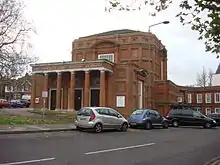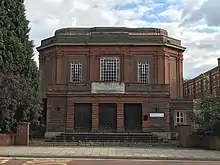W. Braxton Sinclair
Captain William Charles Braxton Sinclair[1] FRIBA (1883 – 29 November 1962) was a British architect who worked in the United Kingdom and in Burma, where he was a captain in the Royal Engineers.[2] He was also a local historian.[3]
Army service
Sinclair was born in Highbury, Middlesex, England,[4] to Charles John Sinclair, an accountant. He joined The Essex Regiment and was promoted to second lieutenant in 1907 in the 3rd Battalion and lieutenant in the 6th Battalion in 1910.[5] As lieutenant, he served with the regiment in the First World War. In the Second World War he served with the Royal Engineers, initially as a lieutenant[6] and later as a captain.[7] Three photographs associated with his war service are held at the National Army Museum.[7]
Works


His works include:
- Silver Birches, a country house in Purley, Surrey (1920s)[8]
- 8 Turner Close, Hampstead Garden Suburb (1920–23),[9] which was listed Grade II in 1970.[10] Its specification and plans are held at the London Metropolitan Archives.[11]
- First Church of Christ, Scientist, Southport, Lancashire, 1924–33, now demolished[12]
- First Church of Christ, Scientist , Bromley[13] (1928–33) at 54B Widmore Road, Bromley, London, which is Grade II listed.[14] The Bromley Civic Society describes it as "an amazing fusion of classicism and Art Deco based on the design of a Roman tomb which accounts for the addition of a Mediterranean cypress tree as part of the integral landscaping. Special features are the classical pilasters in varying thicknesses of brick, repeated in the window tracery and the design of the carved wooden doors. Small hand-made bricks are used throughout."[15] Historic England describes it as being "in an inventive Neo-Classical style with brickwork and doors reminiscent of Art-Deco cinemas".[14]
- Kay & Co's Georgian-style offices (1938) in The Tything, Worcester[16]
- The Tudor-style gatehouse (1939) at the entrance to Dunsborough Park in Ripley, Surrey, commissioned by Sir Oliver Simmonds MP[17][18][19]
- First Church of Christ, Scientist, Richmond (1939–53) at Sheen Road, Richmond, London[20]
- Huddersfield House (1958–59) at 200 Strand, London WC2,[21] the London offices of the then Huddersfield Building Society; the society later merged with other building societies to become the Yorkshire Building Society and the building is now known as Yorkshire House.[22]
In 1913, Sinclair restored the tower at Holy Cross Church in Greenford, north-west London.[23]
In 1950, he extended the neo-Georgian flats that had been built in 1937 in Chesterfield Gardens in Greenwich.[24]
His design of a sophisticated air raid shelter for flats at Queen's Gate, in South Kensington, London, was published in The Builder in October 1938.[25]
Publications
- "Great Greenford, Middlesex: The Ancient Parish and the Unique Church", 12pp., published by the author, December 1912.
- "The monasteries of Bagan" in Journal of the Burma Research Society, vol.10, 1920[26]
- "Prehistoric Blackheath" in Transactions of the Greenwich and Lewisham Antiquarian Society, issue 4 (4), p. 164. T Green & Lewis, 1948–49[27]
- "The Black Heath" in The Journal of the London Society, issue 328, pp. 30–41, 1955[28]
While briefly stationed in York during the Second World War, Sinclair, who was a Georgian Group member, wrote notes which, revised by the Society's architects, became the first publication of the York Georgian Society, Some Hints on the Maintenance and Repair of 17th and 18th Century Premises (1945).[29]
Legacy
Sinclair bequeathed, to the Victoria and Albert Museum, four Burmese pictorial textile hangings known as kalagas.[30][31][32][33] The museum also holds three watercolours by Sinclair, two showing Burmese landscapes[2][34] and one of a Burmese pagoda.[35] After his death Mrs Mary Simpson donated on his behalf, to the Victoria and Albert Museum, an 18th- or 19th-century wooden and lacquered sculpted figure of the Buddha Shakyamuni.[36]
References
- "3rd Volunteer Battalion, Essex Regiment" (PDF). The London Gazette. 28044: 5122. 26 July 1907. Retrieved 6 September 2015.
- "Watercolour of a burmese landscape". Victoria and Albert Museum. Retrieved 16 February 2014.
- Osborne, Mike (2012). Defending London: The Military Landscape from Prehistory to Present. Stroud: The History Press. ISBN 978-0-7524-7931-6.
- 1911 England Census
- "6th Battalion, The Essex Regiment" (PDF). The London Gazette. 28458: 506. 20 January 1911. Retrieved 6 September 2015.
- "Supplement" (PDF). London Gazette. 5 July 1940. Retrieved 28 May 2017.
- "Three photographs associated with Lt William Braxton Sinclair, 6th Bn The Essex Regiment, 1912 (c) and Royal Engineers, 1944 (c)". National Army Museum. Retrieved 3 March 2014.
- "Silver Birches, Designed by Mr. W. Braxton Sinclair". Rostron & Edwards. Retrieved 17 May 2017.
- "Listed buildings" (PDF). Hampstead Garden Suburb Trust. Retrieved 8 November 2014.
- Historic England. "8, Turner Close NW11 (1359078)". National Heritage List for England. Retrieved 9 September 2016.
- "Turner Close, 008: Braxton Sinclair, W." 74 – London Metropolitan Archives: City of London. The National Archives (United Kingdom). Retrieved 18 July 2015.
- Harwood, Elain & Foster, Andrew (1998). "Places of Christian Worship 1914–1990: A Selection of Christian Places of Worship" (PDF). Twentieth Century Society. p. 124. Retrieved 1 July 2014.
- "Churches etc". Art Deco Buildings: London examples. London Footprints. Retrieved 19 January 2013.
- Historic England. "First Church of Christ Scientist (1253930)". National Heritage List for England. Retrieved 17 May 2017.
- Bromley Civic Society and The Friends of Bromley Town Parks (June 2011). "No 3 – Bromley North from Market Square" (PDF). Bromley Town Centre Conservation Area Heritage Walks. Bromley Civic Society. Retrieved 5 October 2014.
- Pevsner, Nikolaus (1968). The Buildings of England – Worcestershire. London: Penguin Books. p. 333. ISBN 0300096607. Retrieved 17 May 2017.
- Kay, Thornton (11 July 2013). "Daemons and dainties dazzle at Dunsborough". Salvo News. Retrieved 27 December 2014.
- "A Pair of Compton Pottery Terracotta 'Snake Pots'". Sale 4300/ Lot 1. Christie's. 2013. Retrieved 16 February 2014.
- Nairn, Ian and Pevsner, Nikolaus, 2nd edition revised by Cherry, Bridget (2002). The Buildings of England – Surrey. New Haven and London: Yale University Press. p. 444. ISBN 0-300-09675-5.CS1 maint: multiple names: authors list (link)
- Cherry, Bridget and Pevsner, Nikolaus (1983). The Buildings of England – London 2: South. London: Penguin Books. p. 519. ISBN 0-14-0710-47-7.CS1 maint: multiple names: authors list (link)
- Pevsner, Nikolaus, 3rd edition revised by Cherry, Bridget (1973). The Buildings of England – London 1: The Cities of London and Westminster. Penguin Books. p. 381. ISBN 0-14-0710-12-4.CS1 maint: multiple names: authors list (link)
- Hamey, Baldwin (25 September 2012). "A bit of Yorkshire in London". London Details – Details you did not know about London. Baldwin Hamey. Retrieved 20 March 2015.
- Cherry, Bridget and Pevsner, Nikolaus (2002). The Buildings of England – London 3: North West. New Haven and London: Yale University Press. p. 181. ISBN 0-300-09652-6.CS1 maint: multiple names: authors list (link)
- Cherry, Bridget and Pevsner, Nikolaus (1983). The Buildings of England – London 2: South. London: Penguin Books. p. 268. ISBN 0-14-0710-12-4.CS1 maint: multiple names: authors list (link)
- Historic England. "Air Raid Shelter (1395422)". National Heritage List for England. Retrieved 17 May 2017.
- "Journal". Journal of the Burma Research Society. Myanmar Book Centre. Retrieved 16 February 2014.
- "Prehistoric Blackheath". British and Irish Archaeological Bibliography. Retrieved 18 July 2015.
- "The Black Heath". British and Irish Archaeological Bibliography. Retrieved 17 May 2017.
- Webb, Katherine A (9 December 2009). "Early Years of the York Georgian Society". York Georgian Society. Retrieved 16 February 2014.
- "Hanging (IS.1–1963)". Victoria and Albert Museum. Retrieved 16 February 2014.
- "Hanging (IS.2–1963)". Victoria and Albert Museum. Retrieved 16 February 2014.
- "Hanging (IS.3–1963)". Victoria and Albert Museum. Retrieved 16 February 2014.
- "Hanging (IS.4–1963)". Victoria and Albert Museum. Retrieved 16 February 2014.
- "Watercolour of a burmese landscape". Victoria and Albert Museum. Retrieved 16 February 2014.
- "Watercolour of a burmese pagoda". Victoria and Albert Museum. Retrieved 16 February 2014.
- "Figure". Buddha Sakyamuni; Sculpture, wood, lacquered gilt, Burma, C18-19. Victoria and Albert Museum. Retrieved 5 October 2014.